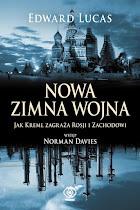By Edward Lucas
To raise money for church repairs in my home village in south-west
England, I have just given an illustrated talk there on 'Scrapes,
scoops and spies' in Eastern Europe.
The first problem was showing how countries could appear and disappear
- that's startling in a region that has not been near an international
frontier since 900 AD.
But I found maps showing Europe in 1914, 1922, 1945 and now, which
illustrated well the crucial interplay between history and geography.
Nor was it too hard showing resistance to communist rule, and the
authorities' response.
For the communist seizure of power in 1945-48, I used pictures of two
of my Czechoslovak heroes, Jan Masaryk (the last non-communist foreign
minister, who fell to his death, probably not unassisted, from the
window of his flat high up in the foreign ministry building) and
Milada Horakova. She survived a Nazi concentration camp only to be
hanged after a communist show trial in 1950.
There were excellent pictures, too, of the East German workers'
uprising of 1953, of Hungary in 1956, of the Soviet-led invasion of
Czechoslovakia in 1968 and of Solidarity in Poland in 1980-81.
But what was missing from the internet were images of the communist
system itself. (I thought it would be cheating to use commercial photo
libraries, so I was relying only on what the general public can find
via the internet search engine, Google.)
I searched in vain for illustrations of the degradation and
frustration of everyday life, of empty shops and squalid housing.
I did find one picture of the world's worst car, the Soviet-made
Zaporozhets - but it was a lovingly restored one owned by an eccentric
American collector, not the usual stinking rusty deathtrap.
Illustrating the moral dimension, of collaboration and deceit, was
even harder.
Some extracts from works by Milan Kundera, Josef Skvorecky and Milan
Klima would have done the job perfectly, given the time to read them
aloud: the real face of totalitarianism is sad, shabby compromises
made by sad, shabby people. That is ideal material for novelists, less
so for photographers.
It was hard too to explain wear and tear on my own nerves. Western
journalists behind the Iron Curtain worried often that we were
endangering our contacts, or (occasionally) that they might compromise
us. Soviet-block foreign correspondents in the West were almost
invariably spies; the communist authorities assumed we were too. That
meant a regular diet of hassles (ranging from blocked phones to
honeytraps) and threats of expulsion.
Sometimes these were comical. In Prague the authorities complained
about my frequent visits to the British embassy.
I was happy to explain that I was going not to pick up secret
instructions, but in the hope that the little shop there might have
new supplies of life-preserving Marmite (a yeasty gunk that Brits eat
spread on hot buttered toast).
In Soviet-occupied Estonia I was the first Western journalist to
interview the head of the KGB in Tallinn. I started the interview by
asking: "Am I the first Westerner to come into this building?" He
replied coolly: "Let's say that you will be the first Westerner to
leave it." I got goosepimples: remembering that anti-communist
partisans sent by Britain (and betrayed by British traitor Kim Philby)
had been tortured and murdered in that very building in the 1950s.
When the KGB collapsed in 1991, the Estonians found a machine in the
basement that, seemingly, had been used for mincing up bodies. Perhaps
I should have got a picture of that.
[ps from Edward: we did use a picture of that mincing machine in the Baltic
Independent when I was editing it]
Thursday, September 01, 2005
wilder europe What did communism look like, Daddy?
Subscribe to:
Post Comments (Atom)








No comments:
Post a Comment